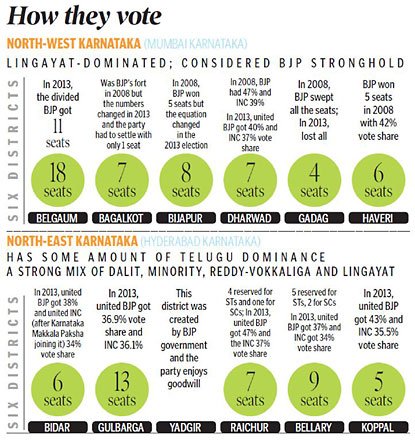A classic case where the BJP may win without any strengths and INC may lose for its weaknesses
Coastal Karnataka
The region has three districts – Dakshina Kannada, Uttara Kannada and Udupi accounting for 19 seats. Coastal Karnataka is the stronghold of the BJP and all the three MP seats are held by it.
However, in the 2013 Assembly elections, the INC did extremely well here winning most of the seats. The BJP then was a divided house but now they are united. The JDS has very little presence and depends on the charisma of individual leaders.
Dakshina Kannada (Mangalore): The district has witnessed a bipolar contest between the BJP and INC in the last few elections. It has been a strong INC bastion but many INC leaders, including Janardhana Poojary, are unhappy with the Chief Minister and district in charge minister on their minority appeasement policies. This might help the BJP consolidate its position here.
Udupi: The BJP had swept this district in 2008 but lost ground in 2013. The united BJP in 2018 is a strong house with mass leaders like Haladi Srinivas Shetty and Jayaprakash Hegde.
Uttara Kannada (Karwar): It witnesses a bipolar contest between the BJP and the INC except in two seats where the JDS is strong. This election, the BJP tried hard to consolidate its position riding on pro-Hindu sentiments.

Old Mysore and Bangalore
Bangalore is part of the Old Mysore region but the voting pattern here is very different from the rest of the region. It has for long been a stronghold of the BJP. Moreover, the major local community of the city – Brahmins — normally favour the BJP.
Though there has been a direct contest between the BJP and the INC, in two seats, the JDS puts up a tough fight. In 2013, even with the divided house, the BJP got 12 seats but in the 2015 BBMP polls, it could get only 100 of the 198 seats.
Bangalore Urban has 28 Assembly constituencies. Rest of the Old Mysore region has 87 Assembly seats in 13 districts — Davangere, Chitradurga, Tumkur, Shimoga, Chikkamagalur, Hassan, Kodagu, Mysore, Chamarajnagar, Mandya, Bangalore Rural, Kolar, Chikkaballapur.
The INC dominates the region. While the BJP is a strong competition in Chikkamagalore, Shimoga, Kodagu, Davanagere, Tumkur, and Bangalore Rural, the JDS is strong in Mysore, Chamarajnagar, Mandya, Hassan, and Ramanagara.
Old Mysore is dominated by Vokkaliga and Kurbas. The BJP is the only party that does not have good support of the Vokkaliga community. With the induction of SM Krishna, a Vokkaliga, the party may gain some confidence of these voters.
A detailed analysis will help us understand the situation of Old Mysore better.
Davangere: The area sees a bipolar contest between the BJP and the INC except in one seat where the JDS too is present.
Chitradurga: Though it has witnessed a bipolar contest between the BJP and INC, independents have surprised them. This election, the united BJP is in a good position with ST leader B Sriramulu back in its fold.
Tumkur: Sees a triangular contest in 8 seats where BJP has a presence. In another three, it’s a contest between the INC and JDS. The JDS has a presence in all the seats.
Shimoga: Is the home district of BS Yeddyurappa and Eshwarappa. Shimoga is also considered as the Karnataka headquarters of the BJP. In a few seats here, it’s a triangular contest and in others, it is a direct fight between the BJP and the INC.
Chikkamagalur: In 2008, the BJP had won 4 seats but as a divided house, it could only win 2 seats. The minority politics of the INC will help the BJP consolidate Hindu voters here.
Hassan: It is the home district of HD Deve Gowda and the JDS is very strong here. This election we may witness a rise in BJP vote share owing to its Parivarthana Yatra.
Kodagu (Madikeri): Support for Tipu Jayanti by the INC would polarise votes in favour of the BJP.
Mysore: It is Chief Minister Siddaramaiah’s home district. It would be a tough fight between the INC and JDS.
Chamarajnagar: Sees a triangular contest among the BJP, INC, and the JDS-BSP alliance. The results here would be very interesting as the JDS and the BSP have joined hands and prominent Dalit leader Sreenivasa Prasad has joined the BJP.
Mandya: The fight is between the INC and the JDS. BJP doesn’t have a presence in this district.
Bangalore Rural: In 2008, the BJP won 3 seats but lost all in 2013 election. Bangalore Rural is now dominated by the JDS.
Kolar: This is one of the rare areas where independents have a stronghold. — Concluded
Also Published at https://telanganatoday.com/too-tough-to-call




